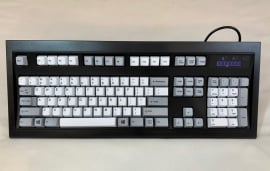this post was submitted on 04 Jul 2023
18 points (100.0% liked)
Mechanical Keyboards
8972 readers
44 users here now
Are you addicted to the clicking sounds of your beautiful and impressive mechanical keyboard?
If so, this community is for you!
Here you can discuss everything about mechanical keyboards (and only mechanical keyboards).
Banner by Jay Zhang on Unsplash
founded 4 years ago
you are viewing a single comment's thread
view the rest of the comments
view the rest of the comments

i agree it's a little pricey for what you get but my fingers only want leaf springs but i can confirm that the new model m has 6 key rollover. the standard spec for USB keyboards. NKRO would be nice but I also heard there would be issues with bios not seeing the keyboard on older systems. I have not verified that though.
Hm, must have googled that spec wrong, to be fair, they don't list it on the product page.
agreed i can totally see how you came to that conclusion. i only mention it cause I thought the same thing but was surprised when I did the keyboard test. becase the old Ms only had 2 like you said.
They're not 6KRO. All Model Ms are membrane keyboards, which make implanting diodes difficult, so they're fundamentally 2KRO.
to clarify this is the new model m from unicomp not an OG model m. I have the new model m right in front of me and can confirm it's 6KRO
I also have a New Model M. It uses the same matrix Unicomp has used for years with their Ultra Classic and EnduraPro keyboards. As such, you should be able to observe 2KRO by pressing any 3 WASD keys together (and see my matrix simulator to find more examples).
I don't mean to sound like an arsehole, but it's not a matter of debate; a conductive membrane using a key-matrix is practically limited to 2KRO. You'd either need to stick diodes in (which is harder and not cost-effective to do with membranes versus PCBs) to prevent back current from ghosting keys, or you'd need dedicated traces for each switch position instead of using a matrix (which is costly in traces and the design of controller you'd need for that). Because neither is a practical option, the controller must block keys susceptible to ghosting because not sending all intended keys is preferable to reporting keys not even being pressed. In a key-matrix without diodes, 2 is the maximum number of any given keys guaranteed to be reliably sensed and reported together, thus Model Ms (like most membrane keyboards) are 2KRO. That doesn't mean more keys can be pressed under certain situations - the matrix is like a table of traces, having columns and rows and what combinations are being used matters - but it doesn't change that key rollover means the maximum guarantee across all keys and the number in this case is 2. Not the maximum possible key combination under any condition. I think that part is what confuses a lot of people (which is understandable, I've seen it misrepresented for marketing and used as a buzzword). But, Deskthority Wiki describes as such which is probably generally easier to understand:
I'd be surprised if this is not the case with your keyboard. With the Unicomp Mini M, they improved supported combinations by making the matrix larger (from 16x8 for New M to 16x12) and then using maths you can find out where in the matrix the most commonly used keys should go, but you can still observe 2KRO on a Mini M by trying to press any 3 arrow keys down.